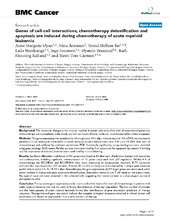| dc.contributor.author | Øyan, Anne Margrete | en_US |
| dc.contributor.author | Ånensen, Nina | en_US |
| dc.contributor.author | Bø, Trond Hellem | en_US |
| dc.contributor.author | Stordrange, Laila | en_US |
| dc.contributor.author | Jonassen, Inge | en_US |
| dc.contributor.author | Bruserud, Øystein | en_US |
| dc.contributor.author | Kalland, Karl-Henning | en_US |
| dc.contributor.author | Gjertsen, Bjørn Tore | en_US |
| dc.date.accessioned | 2014-11-21T10:21:05Z | |
| dc.date.available | 2014-11-21T10:21:05Z | |
| dc.date.issued | 2009-03-05 | eng |
| dc.identifier.issn | 1471-2407 | |
| dc.identifier.uri | https://hdl.handle.net/1956/8774 | |
| dc.description.abstract | Background: The molecular changes in vivo in acute myeloid leukemia cells early after start of conventional genotoxic chemotherapy are incompletely understood, and it is not known if early molecular modulations reflect clinical response. Methods: The gene expression was examined by whole genome 44 k oligo microarrays and 12 k cDNA microarrays in peripheral blood leukocytes collected from seven leukemia patients before treatment, 2–4 h and 18–24 h after start of chemotherapy and validated by real-time quantitative PCR. Statistically significantly upregulated genes were classified using gene ontology (GO) terms. Parallel samples were examined by flow cytometry for apoptosis by annexin V-binding and the expression of selected proteins were confirmed by immunoblotting. Results: Significant differential modulation of 151 genes were found at 4 h after start of induction therapy with cytarabine and anthracycline, including significant overexpression of 31 genes associated with p53 regulation. Within 4 h of chemotherapy the BCL2/BAX and BCL2/PUMA ratio were attenuated in proapoptotic direction. FLT3 mutations indicated that non-responders (5/7 patients, 8 versus 49 months survival) are characterized by a unique gene response profile before and at 4 h. At 18–24 h after chemotherapy, the gene expression of p53 target genes was attenuated, while genes involved in chemoresistance, cytarabine detoxification, chemokine networks and T cell receptor were prominent. No signs of apoptosis were observed in the collected cells, suggesting the treated patients as a physiological source of pre-apoptotic cells. Conclusion: Pre-apoptotic gene expression can be monitored within hours after start of chemotherapy in patients with acute myeloid leukemia, and may be useful in future determination of therapy responders. The low number of patients and the heterogeneity of acute myeloid leukemia limited the identification of gene expression predictive of therapy response. Therapy-induced gene expression reflects the complex biological processes involved in clinical cancer cell eradication and should be explored for future enhancement of therapy. | en_US |
| dc.language.iso | eng | eng |
| dc.publisher | BioMed Central | eng |
| dc.rights | Attribution CC BY | eng |
| dc.rights.uri | http://creativecommons.org/licenses/by/2.0 | eng |
| dc.title | Genes of cell-cell interactions, chemotherapy detoxification and apoptosis are induced during chemotherapy of acute myeloid leukemia | en_US |
| dc.type | Peer reviewed | |
| dc.type | Journal article | |
| dc.date.updated | 2013-08-28T16:57:19Z | |
| dc.description.version | publishedVersion | en_US |
| dc.rights.holder | Anne Øyan et al.; licensee BioMed Central Ltd. | |
| dc.rights.holder | Copyright 2009 Øyan et al; licensee BioMed Central Ltd. | |
| dc.source.articlenumber | 77 | |
| dc.identifier.doi | https://doi.org/10.1186/1471-2407-9-77 | |
| dc.identifier.cristin | 355474 | |
| dc.source.journal | BMC Cancer | |
| dc.source.40 | 9 | |

